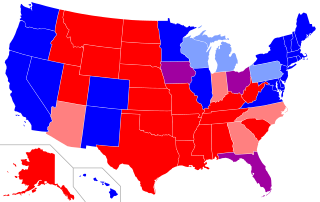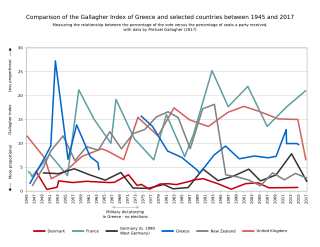
Proportional representation (PR) refers to a type of electoral system under which subgroups of an electorate are reflected proportionately in the elected body. The concept applies mainly to political divisions among voters. The essence of such systems is that all votes cast – or almost all votes cast – contribute to the result and are effectively used to help elect someone – not just a bare plurality or (exclusively) the majority – and that the system produces mixed, balanced representation reflecting how votes are cast.

Party-list proportional representation (list-PR) is a subset of proportional representation electoral systems in which multiple candidates are elected through their position on an electoral list. They can also be used as part of mixed-member electoral systems.
The electoral threshold, or election threshold, is the minimum share of all the votes cast that a candidate or political party requires to achieve before they become entitled to representation or additional seats in a legislature. This limit can operate in various ways, e.g. in party-list proportional representation systems where an electoral threshold requires that a party must receive a specified minimum percentage of votes, either nationally or in a particular electoral district, to obtain seats in the legislature. In Single transferable voting the election threshold is called the quota and it is possible to pass it by use of first choice votes alone or by a combination of first choice votes and votes transferred from other candidates based on lower preferences. In mixed-member-proportional (MMP) systems the election threshold determines which parties are eligible for top-up seats in the legislative body.
Single non-transferable vote or SNTV is an electoral system used to elect multiple winners. It is a generalization of first-past-the-post, applied to multi-member districts with each voter casting just one vote. Unlike FPTP, which is a single-winner system, in SNTV multiple winners are elected, typically in electoral districts; additionally, unlike FPTP, SNTV produces mixed representation and makes it unlikely for a single party to take all the seats in a city or a province, which can happen under FPTP.
The D'Hondt method, also called the Jefferson method or the greatest divisors method, is a method for allocating seats in parliaments among federal states, or in party-list proportional representation systems. It belongs to the class of highest-averages methods.
The Webster method, also called the Sainte-Laguë method or the major fractions method, is an apportionment method for allocating seats in a parliament among federal states, or among parties in a party-list proportional representation system.
A highest-averages method, also called a divisor method, is a class of methods for allocating seats in a parliament among agents such as political parties or federal states. A divisor method is an iterative method: at each iteration, the number of votes of each party is divided by its divisor, which is a function of the number of seats currently allocated to that party. The next seat is allocated to the party whose resulting ratio is largest.

The Unionist Party was the main centre-right political party in Scotland between 1912 and 1965.
The largest remainder method is one way of allocating seats proportionally for representative assemblies with party list voting systems. It contrasts with various highest averages methods.

Starting with the 2000 United States presidential election, the terms "red state" and "blue state" have referred to U.S. states whose voters vote predominantly for one party — the Republican Party in red states and the Democratic Party in blue states — in presidential and other statewide elections. By contrast, states where the vote fluctuates between the Democratic and Republican candidates are known as "swing states" or "purple states". Examining patterns within states reveals that the reversal of the two parties' geographic bases has happened at the state level, but it is more complicated locally, with urban-rural divides associated with many of the largest changes.
An electoral swing analysis shows the extent of change in voter support, typically from one election to another, expressed as a positive or negative percentage. A multi-party swing is an indicator of a change in the electorate's preference between candidates or parties, often between major parties in a two-party system. A swing can be calculated for the electorate as a whole, for a given electoral district or for a particular demographic.

The Gallagher index measures an electoral system's relative disproportionality between votes received and seats in a legislature. As such, it measures the difference between the percentage of votes each party gets and the percentage of seats each party gets in the resulting legislature, and it also measures this disproportionality from all parties collectively in any one given election. That collective disproportionality from the election is given a precise score, which can then be used in comparing various levels of proportionality among various elections from various electoral systems. The Gallagher index is a statistical analysis methodology utilised within political science, notably the branch of psephology.
In electoral systems, a wasted vote is any vote that does not receive representation in the final election outcome. This includes lost votes for a losing candidate or party, and excess votes for winning candidates in excess of the minimum needed to win. When applied to ranked-vote systems, it includes exhausted votes, votes where none of the candidates the voter ranked are elected. Wasted vote share changes from one election to another depending on voter behavior. Wasted votes can lead to political apathy.
The Huntington–Hill method is a method for proportional allocation of the seats in a representative assembly by minimizing the percentage differences in the number of constituents represented by each seat. Edward Huntington formulated this approach, building on the earlier work of Joseph Adna Hill, and called it the method of equal proportions. Since 1941, this method has been used to apportion the 435 seats in the United States House of Representatives following the completion of each decennial census.
Apportionment is the process by which seats in a legislative body are distributed among administrative divisions, such as states or parties, entitled to representation. This page presents the general principles and issues related to apportionment. The page Apportionment by country describes specific practices used around the world. The page Mathematics of apportionment describes mathematical formulations and properties of apportionment rules.
Swing, in the politics of the United Kingdom, is a number used as an indication of the scale of voter change between two political parties. It originated as a mathematical calculation for comparing the results of two Parliamentary constituencies. The UK uses a first-past-the-post voting system. The swing is the percentage of voter support minus the comparative percentage of voter support corresponding to the same electorate or demographic.

The 1920 United States presidential election in New Mexico took place on November 2, 1920. All contemporary forty-eight States were part of the 1920 United States presidential election. Voters chose three electors to represent them in the Electoral College, which voted for President and Vice President.

The 1892 United States presidential election in Georgia took place on November 8, 1892, as part of the wider United States presidential election. Voters chose 13 representatives, or electors, to the Electoral College, who voted for president and vice president.
Apportionment in the Hellenic Parliament refers to those provisions of the Greek electoral law relating to the distribution of Greece's 300 parliamentary seats to the parliamentary constituencies, as well as to the method of seat allocation in Greek legislative elections for the various political parties. The electoral law was codified for the first time through a 2012 Presidential Decree. Articles 1, 2, and 3 deal with how the parliamentary seats are allocated to the various constituencies, while articles 99 and 100 legislate the method of parliamentary apportionment for political parties in an election. In both cases, Greece uses the largest remainder method.
The seats-to-votes ratio, also known as the advantage ratio, is a measure of equal representation of voters. The equation for seats-to-votes ratio for a political party i is:












